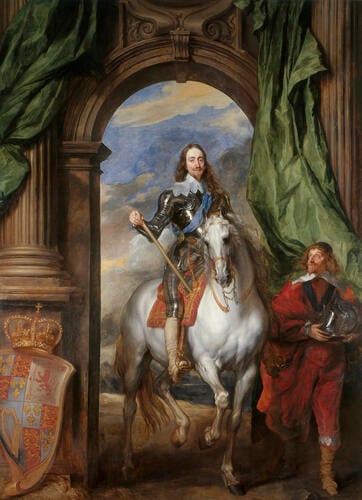-
1 of 253523 objects
Charles I (1600-1649) with M. de St Antoine Dated 1633
Oil on canvas | 370 x 270 cm (support, canvas/panel/stretcher external) | RCIN 405322
-
On his appointment as Principal Painter to Charles I in 1632, the Flemish artist Van Dyck - Rubens's most gifted follower - was required to specialise in portraiture. This is one of the chief paintings to result from his appointment, which revolutionised British painting and provided us with the enduring image of the Stuart court. With great fluency Van Dyck here portrays Charles I on horseback on an unprecedented scale, as ruler, warrior and knight, in the long tradition of antique and Renaissance equestrian monuments. The prominent display of the crowned royal arms and the triumphal arch framing the armed King reinforce his image as ruler of Great Britain, while the King's refined features, loose hair and the sash of the Order of the Garter worn over his armour convey the impression of a chivalrous knight. Van Dyck may have designed the painting for its first position at the end of the Gallery at St James's Palace, where its theatrical effect impressed visitors. Both artist and patron admired and collected works by Titian, but a more direct influence was Rubens's 1603 portrait of the Duke of Lerma (Madrid, Prado) which Charles I would have seen on his visit to Spain as Prince of Wales in 1623.
Skilled horsemanship was regarded as the epitome of virtu and here Pierre Antoine Bourdin, Seigneur de St Antoine, a master in the art of horsemanship, carries the King's helmet. Sent by Henry IV of France to James I with a present of six horses for Henry, Prince of Wales, in 1603, he remained in the service of the Prince and later of Charles I, as riding master and equerry. He looks up at the King, whose poise stabilises a scene filled with baroque movement.
Van Dyck went on to paint two other major portraits of the King with a horse: Charles I on horseback, c.1636-8 (London, National Gallery) and Le Roi à la Chasse, c.1635 (Paris, Louvre). The present painting hung at Windsor Castle for much of the nineteenth century; it is recorded in the Queen's Presence Chamber and the Queen's Gallery (also known as the Van Dyck Room).
Catalogue entry adapted from Royal Treasures, A Golden Jubilee Celebration, London 2002Provenance
Painted for Charles I; recorded in the Gallery at St James's Palace in 1639 (no 1); sold from there to Pope on 22 December 1652 for £150 (no 279); recovered at the Restoration and listed in the room called 'Paradise' at Hampton Court in 1666 (no 80); the painting spend most of the 18th century in the King's Gallery at Kensington Palace, before briefly appearing at Buckingham Palace in 1790; removed to Windsor Castle in 1805, it appears there in the Queen's Presence Chamber in Pyne's illustrated Royal Residences of 1819 (RCIN 922099).
-
Creator(s)
Acquirer(s)
-
Medium and techniques
Oil on canvas
Measurements
370 x 270 cm (support, canvas/panel/stretcher external)
418.5 x 319.5 cm (frame, external)
405 x 306 cm (frame, external, without buildup)
365.3 x 266.8 cm (frame, rebate)
Other number(s)
Alternative title(s)
Charles I (1600-1649) with Pierre Antoine Bourdin, Seigneur de St Antoine
Charles I (1600-1649) with the Duc d'Epernon, previously identified as
